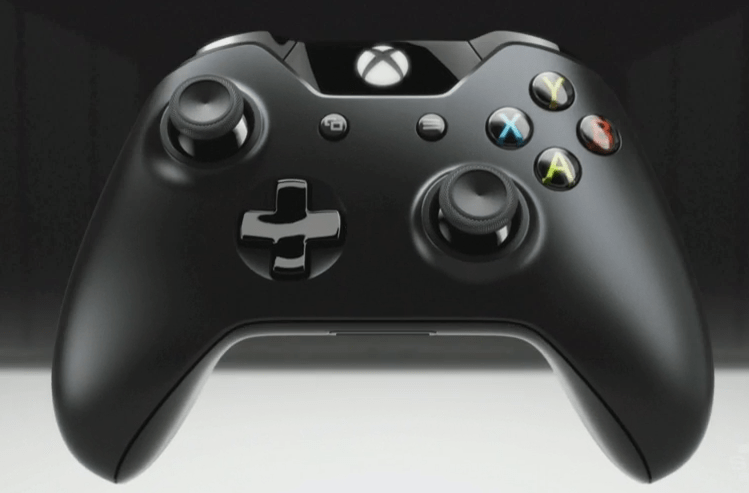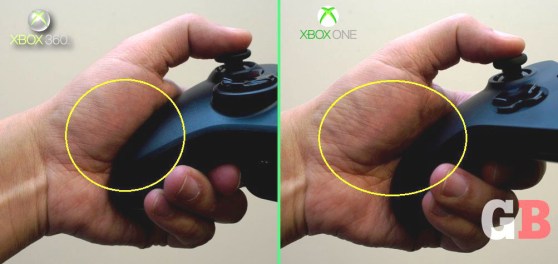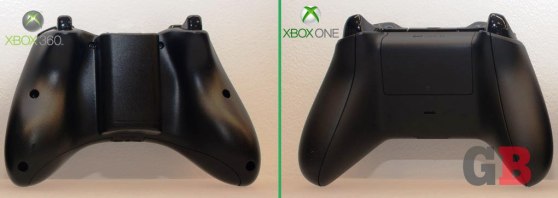This is part of our ongoing series about games and trends of the upcoming next generation. For the PlayStation 4 version of this article, go here.
The Xbox One controller:
- Part 1: Projectors, smells (!), and other stuff that didn’t make it in
- Part 2: What’s new with the analog sticks and D-pad
- Part 3: What’s new with the buttons and triggers
- Part 4: A close look at the new rumble, faster speed, design, and everything else
We looked at early versions of the Xbox One controller in the first article in this series, and we saw some of the ideas that Microsoft considered or even built into working prototypes. But the big feature that the company really got behind was haptics, rumble-based feedback that’s more advanced and refined than what you’re used to today.
In part four, we wrap up our exclusive deep-dive look at Argos — Microsoft’s code name for the next-gen joypad — right in time for the system’s launch tomorrow. We examine the new haptics system, plus how the company optimized the design of the controller for comfort, functionality, and four-hour blocks of shooting things.
The haptics (aka rumble)
You might have already heard or read about what’s shakin’. Traditional controllers have two variable-speed motors in the base of the grips that spin up to rumble in sync with any onscreen action, but the Xbox One edition ups that number. This offers a few benefits.
The new motors sit in different locations and all operate independently, so a game could ping each one to work in conjunction with the each other, providing a rolling “wave” of motion, so to speak. Think of it as the surround sound of rumble, where the vibrations can start in one corner and then circle around the controller like an angry swarm of bees trying to get out.
Now, don’t ask us how this would enhance a typical gaming session, but the option’s there for developers. “You get directionality [in the rumble],” Xbox senior industrial designer Quintin Morris told GamesBeat. “You get forward and back, as well as the left and right that you had before.”
That “forward and back” is possible because the new motors are located where they can make the biggest impact. “They’re called ‘impulse triggers,'” Morris said of the redesigned LT and RT buttons on the shoulders (read more about them here). “We put impulse motors right at your fingertips, which is the most sensitive part of your hand, to really let you feel more of the multidirectional haptic experience.”
The trigger rumble is also more refined since those motors are really tiny — games can push out more nuanced action to them. “To discern between a heartbeat and a rifle shot and a bazooka shot,” said Zulfi Alam, the general manager for accessories at Xbox, “or to have that amount of fidelity as a car spins out and goes over the gravel — you really need the feeling brought to your fingertips. We actually built the technology to have many small, minute motors built inside the triggers themselves. You have to feel it to understand what it is, but the feeling is absolutely wonderful. It was a maniacal focus on trying to make sure that we get it right.”
The bandwidth and latency
You may not even realize it, but your Xbox 360 wireless controller is slooooww — at least when you compare it to its younger brother. “[We’ve increased] the bandwidth of the Xbox One controller by 20 times from the original controller,” said Alam. “It has a hell of a lot more ability to send data and get data from the console. The other thing we did was we reduced the latency. We measured this in the labs. These are milliseconds we’re talking about. The act of pressing a trigger and seeing the response on the screen — we improved that time frame by 20 percent. Shaving milliseconds is huge. Each millisecond you save, it’s like, ‘Oh my God.’
“To do that, we actually had to go inside and change the wireless protocol. We invented a new one. This is not using Wi-Fi, Bluetooth, any of the other standards that are out there. This is a custom protocol designed by Microsoft that is super-optimized specifically for gaming.”
This seems like the type of improvement the average consumer wouldn’t pick up on, but Alam thinks it’ll be a bigger deal in the near future. “Two or three years from now, [maybe] next year, you’ll start seeing a bunch of products on the market that use that extra bandwidth,” he said. “It’s really important. The fact that we invested heavily in latency — it’s an invisible feature, but gamers will notice. ‘Hey, I can play much better with this thing than I used to.’ The expansion port [at the bottom of the controller] is high bandwidth. You should be able to do a whole bunch of different things over the coming years on this expansion port.”
The grips
This must be the most difficult thing for an engineer to figure out: Whose mitts do you design a controller for? “We knew that the age range of gamers is changing,” said Morris. “Younger kids are playing. Younger kids holding a controller — they can struggle to get a grip. There’s also more women playing video games than ever before. Women tend to have smaller hands than men, so [we have to take that into consideration].”
As mentioned in part one of this series, Microsoft went through hundreds of prototypes, and many of them were simply small, increment tweaks — adding or shaving a millimeter here or there — in searching for the perfect, one-size-fits-all model. It knew the classic two handles (or grips — or lobes, as MS tends to call them during our interviews) work well, but it still sought out something that was easier to hold for most gamers.
The solution that it came up with is rather interesting — a fix for a problem no one knew they had. “We looked at the mechanics of the hand,” said Morris. “If you look at the way that you hold this controller, the way it’s shaped, you tend to push the handle up into the thumb joint. That really restricts the ability for your thumb to get around the controller.”
When Morris showed this to us, he pointed out that the fat muscle that helps to pull your thumb in, located at the base of your palm and under the thumb, tends to smush right into the 360 controller’s grips. “We wanted to get that handle down into the [lower] part of your palm so that you weren’t interfering with this joint at all,” said Morris.
In other words, Microsoft slimmed and sloped down the tops of the handles so that they won’t get in the way of the thumb and its attached muscles. “Just that one improvement alone will mean that your mobility — the mobility of your thumbs as they move around the controller — will be that much better,” said Morris.
The weight and center of gravity
You might not think much about it (unless you’re holding the original PlayStation 3 Sixaxis), but how heavy your controller is can change how you perceive its quality. “We continued to test attributes like weight,” said Morris. “A heavier thing tends to feel more premium, but if you’re playing for a long time, a heavy thing can cause fatigue.”
Microsoft has an entire set of prototypes that differ only by fractions of a gram, so they can focus-test the various options. But just how does one make a controller heavier? We’d like to think that involves engineers squeezing mouse-sized barbell weight plates into the controller, but it’s actually much simpler than that. “If you were going to add weight,” said Morris, “you could do it through materials selection. A metal housing versus a plastic housing, for example. Sometimes you actually add bits of metal that are just there to change the center of gravity and change the weight.”
Microsoft didn’t really have to do that, instead removing the bulky battery pack from the back and forcing that housing inside, deeper into the body of the controller. This not only results in a more comfortable fit for your non-thumb digits — the back is all flat and smooth now — but also slightly shifts everything toward you in a very subtle fashion. “The way that we integrated the battery,” said Morris, “it actually moves the center of gravity closer to you. That’s good because with the battery below and forward, the Xbox 360 controller wants to fall forward out of your hands. Whereas the Xbox One controller puts that weight closer to the palms of your hand. It’s easier to hold, which also reduces fatigue.”
The design
If you think that attention to detail is ridiculously small and anal-retentive … well, we’re not done yet.
Turn your Xbox 360 controller over and look at its backside. See those holes? And that physical seam where the back (white by default) meets the other color (gray) toward the bottom? Those are now gone. “It’s a huge deal,” said Alam. “If you’re a core gamer and you’re playing Call of Duty for four hours and your hand has been sitting in the same spot and gripping tightly — you find that people develop calluses from the screw areas. It’s not the most comfortable thing. You don’t feel it in a 15-minute game session. An hour, two hours, three hours, you start to wonder, ‘Why isn’t this a smooth surface?’ That’s the kind of question we asked ourselves.
“So we got rid of the screws [and the seam]. This is a screwless design. There is technology available that allows us to eliminate this. Yes, it’s more cost. Yes, it takes a bit out of our pocket to make sure this happens. But it’s the right thing for the consumer.”
Dishing out the dough to make sure we can play Call of Duty comfortably for four hours straight? And here you thought all Microsoft wanted was for you to spend all your time watching cable TV through the Xbox One.
The rest of the series:
- Part 1: Projectors, smells (!), and other stuff that didn’t make it in
- Part 2: What’s new with the analog sticks and D-pad
- Part 3: What’s new with the buttons and triggers
- Part 4: A close look at the new rumble, faster speed, design, and everything else
Photo credits (nonstock shots): Jeff Emtman. Special thanks to VentureBeat reporter Tom Cheredar for the image-editing help.
VentureBeat's mission is to be a digital town square for technical decision-makers to gain knowledge about transformative enterprise technology and transact. Learn More





